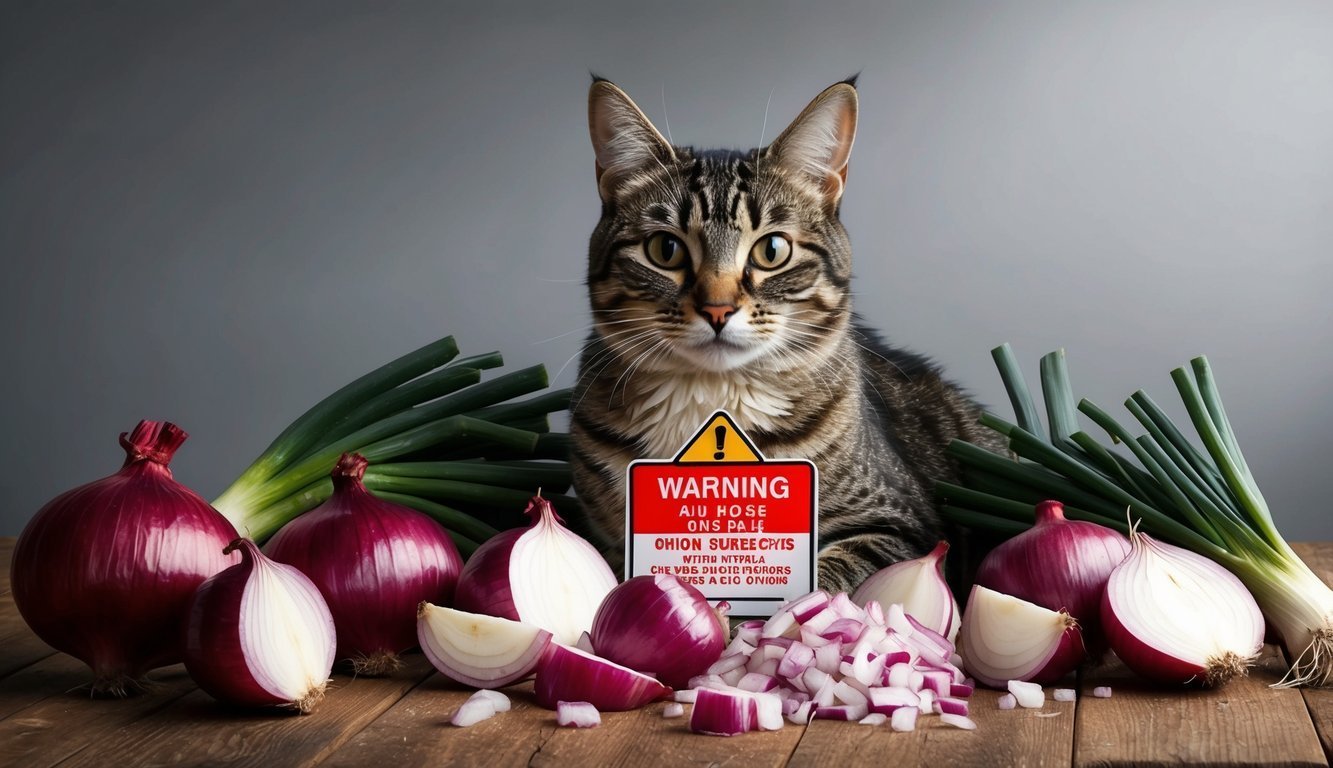Onions are a common kitchen staple, but they can pose a significant risk to your feline friend.
Many cat owners may not realize this, and the potential dangers associated with even small quantities. Studies indicate that as little as 0.5% of a cat’s body weight in onions can lead to serious health issues, including Heinz body anemia.
Understanding the impact of onions on your cat’s health is crucial for responsible pet ownership.
Your cat’s sensitivity to certain foods means that precaution is essential.
If your cat has consumed onion, recognizing the signs of toxicity and knowing how to respond can be lifesaving.
As a proactive pet owner, you must be aware of which foods can harm your furry companions and how to prevent accidental ingestion.
Knowing how much onion is toxic to cats could mean the difference between a healthy pet and an emergency trip to the vet.
Key Takeaways
- Onions are highly toxic and can lead to serious health problems in cats.
- Symptoms of onion toxicity can include lethargy, vomiting, and breathlessness.
- Preventing access to onions can help keep your cat safe and healthy.
Understanding Onion Toxicity in Cats
Onion toxicity poses significant risks to your cat’s health.
Knowing what makes onions toxic and recognizing the symptoms of onion poisoning can help you act promptly if your pet consumes this harmful ingredient.
What Makes Onions Toxic to Cats
Onions contain a compound called n-propyl disulfide, which is particularly harmful to cats.
Unlike humans, felines lack the necessary enzymes to process this substance effectively.
When ingested, n-propyl disulfide causes oxidative damage to red blood cells, leading to a condition known as Heinz body anemia.
This type of anemia disrupts the cat’s ability to transport oxygen throughout the body, resulting in serious health issues.
All forms of onions—raw, cooked, powdered, or dried—are toxic.
Even small amounts can cause adverse effects, particularly in sensitive cats, such as kittens.
For instance, as little as one gram of onion can be lethal for a kitten due to their smaller size and higher sensitivity.
Symptoms of Onion Toxicity
Recognizing the symptoms of onion toxicity is crucial for prompt treatment.
Common signs include:
- Weakness or lethargy
- Vomiting
- Diarrhea
- Abdominal pain
- Pale gums
These symptoms can appear anywhere from a few hours to several days after ingestion.
As the condition progresses, your cat may also show increased heart rate and breathing difficulties.
If you observe any of these symptoms after your cat has consumed onions, it’s important to contact your veterinarian immediately.
Early intervention can be the key to a successful recovery.
Common Alliums That Affect Cats
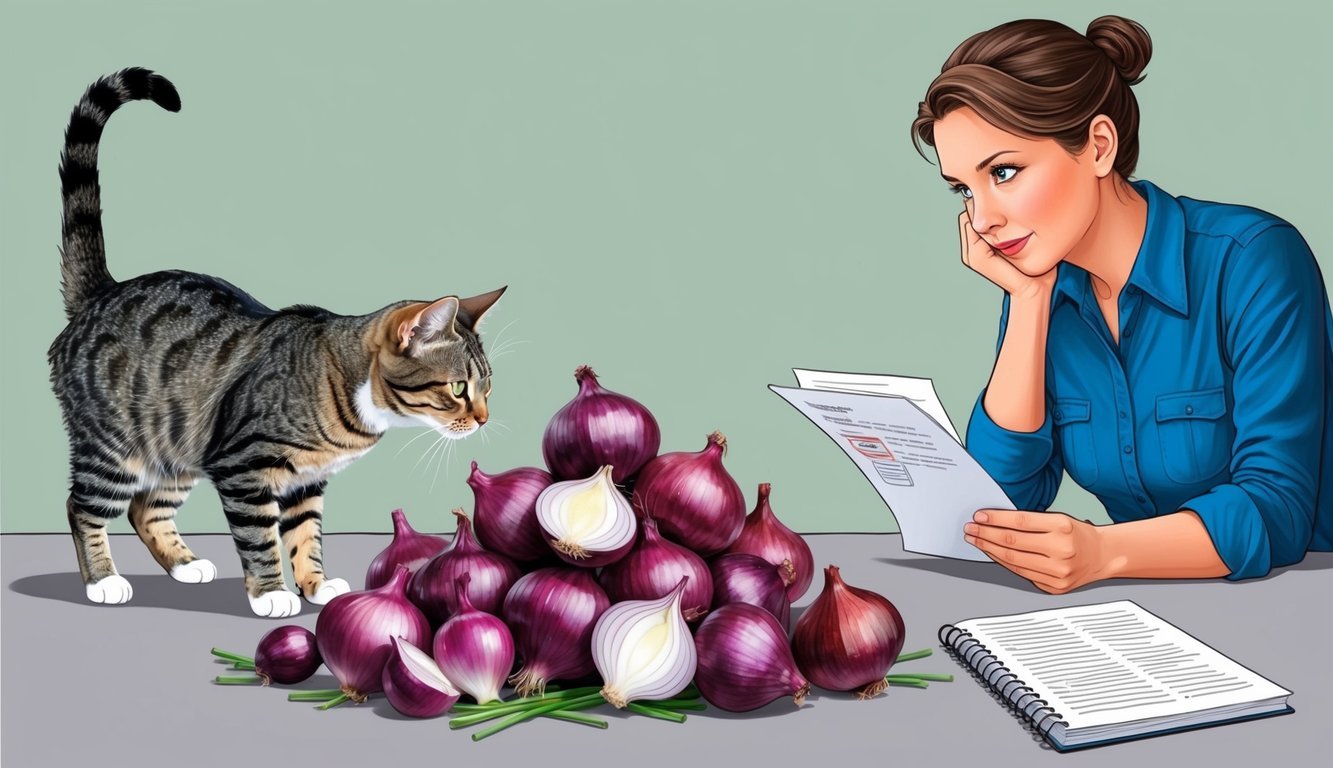
Many common alliums can pose a serious risk to cats.
Understanding which of these foods to avoid is crucial for their health.
Here’s a closer look at the most commonly encountered alliums.
Garlic and Its Potency
Garlic is part of the allium family and is significantly more toxic to cats than onions.
It contains compounds that induce oxidative damage to red blood cells.
The toxic effects can lead to a condition known as Heinz body anemia.
Even small amounts of garlic can be harmful.
Symptoms of garlic toxicity include vomiting, diarrhea, and lethargy.
It’s essential to be cautious with any food containing garlic, such as sauces, seasonings, or pre-packaged meals.
Shallots, Leeks, and Chives
Shallots and leeks, along with chives, are also part of the allium genus and can be harmful to cats.
These vegetables contain similar toxic compounds that can lead to blood cell damage.
Shallots are particularly dangerous, being about three to five times more toxic than regular onions.
Chives are less harmful but can still cause issues.
Symptoms of ingestion include gastrointestinal upset and willingness to eat less.
Always keep these foods out of your cat’s reach.
How Cats May Ingest Onions
Cats may encounter onions in various unexpected ways, leading to potential toxicity.
It’s essential to recognize how your cat might unknowingly consume onions, as this can help you take preventive measures.
Here are two common scenarios where ingestion can occur.
Hidden Onions in Foods
Many human foods contain onions or onion powder without you realizing it.
For example, sauces, soups, and prepared meals often include these ingredients.
When you share table scraps with your cat, there’s a risk they might ingest onions.
Check the ingredient labels for products containing onions.
Common sources include:
- Salsas
- Gravies
- Pre-packaged meals
Cats are naturally curious and may be tempted to sample what’s on your plate.
It’s vital to keep these foods out of their reach.
Always be cautious about what you feed your feline friend.
The Dangers of Cooked Onions and Onion Powder
While raw onions are toxic, cooked onions are also a hazard.
Cooking alters the chemical composition, but the harmful compounds remain.
For instance, caramelized onions often found in dishes can still pose a risk to your cat.
Onion powder is particularly concerning.
It’s concentrated, meaning even a small amount can be harmful.
If your cat has access to seasoning or leftovers flavored with onion, they could ingest it accidentally.
Prevent your cat from sneaking into food storage.
Always store foods containing onions securely.
This vigilance will help keep your cat safe from onion toxicity.
Assessing the Risk and Response
Understanding how much onion can be toxic to your cat and knowing how to respond is vital for their safety.
Quick action can help mitigate the effects of onion toxicity, so being informed is essential.
Quantity of Onions and Levels of Toxicity
Cats can be sensitive to onions, which contain compounds harmful to their red blood cells.
The risk of toxicity increases with the amount consumed.
As a guideline, ingesting more than 1 gram of onion per 5 pounds of body weight can lead to toxic effects.
Onion forms to be aware of:
- Raw onions
- Cooked onions
- Onion powder (which is more potent)
Even small amounts in foods should raise a red flag.
Know that symptoms may not appear immediately, so vigilance is key.
Immediate Steps if a Cat Eats Onion
If your cat eats onion, take quick action. Inducing vomiting may prevent further absorption of the toxin, but this should only be done if advised by a veterinarian.
You can contact your emergency vet for specific instructions.
Checklist of immediate steps:
- Contact your vet or local animal poison control.
- Provide details: Know your cat’s weight and how much onion was consumed.
- Monitor for symptoms: Watch for lethargy, weakness, or unusual behavior.
Prompt action can make a significant difference in outcomes.
Treatment for Onion Toxicity
If your cat shows symptoms or if ingestion exceeds safe limits, professional veterinary care is necessary.
Treatment will vary based on the severity of the situation.
Possible treatments include:
- Inducing vomiting if ingestion was recent.
- Intravenous fluids to assist in flushing out the toxins.
- Medications to support red blood cell function and overall recovery.
Depending on the severity, recovery can take a few days to several weeks.
Always follow your veterinarian’s advice for the best outcome.
Long-Term Health Implications
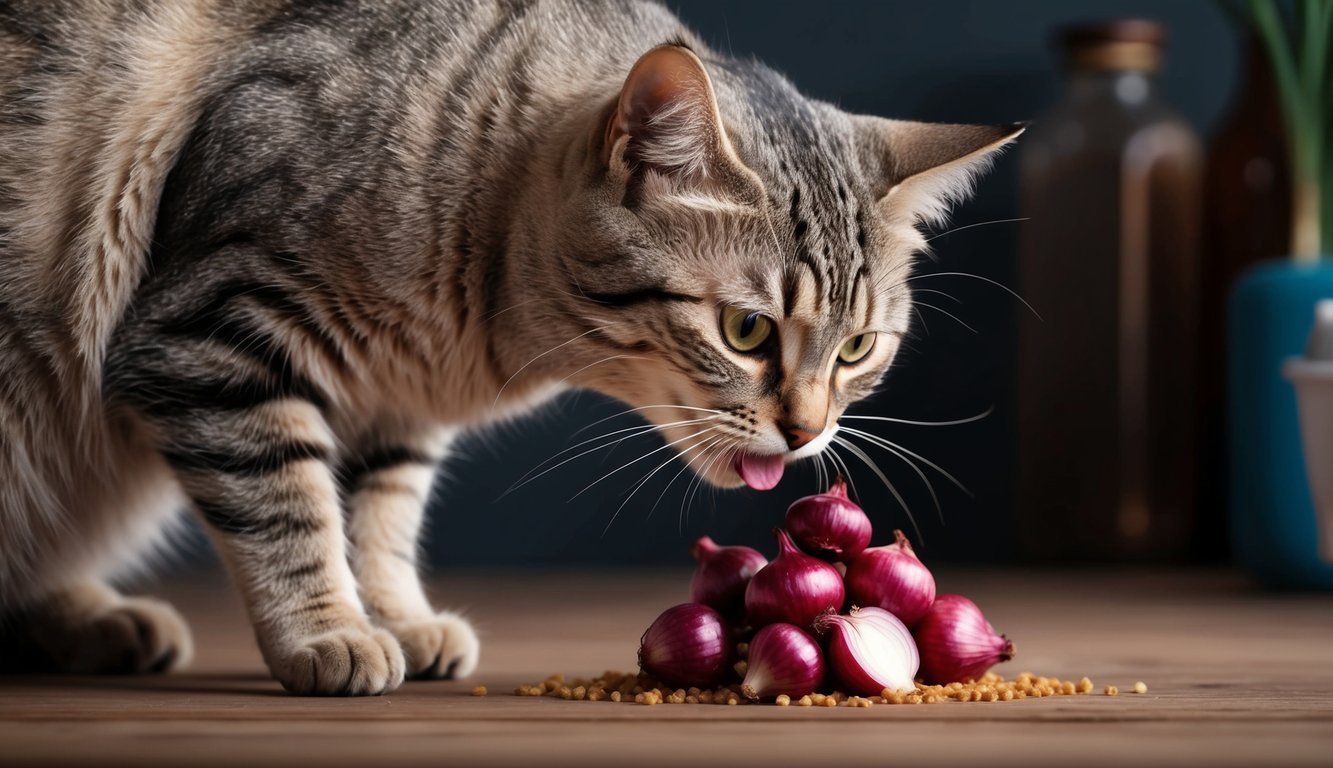
When it comes to onion toxicity in cats, the long-term health implications can be significant, particularly if your cat has been exposed chronically or has developed anemia.
Understanding these effects can help you take the necessary steps to safeguard your pet’s health.
Chronic Exposure to Onions
Consistent exposure to onions can lead to severe health problems over time.
Even small amounts, if ingested regularly, can accumulate and cause oxidative damage to red blood cells.
This damage results in Heinz body anemia, a serious condition where red blood cells become fragile and break down prematurely.
Symptoms of chronic exposure may not appear immediately.
This delay can mislead you into thinking there’s no issue.
Instead, your cat may show signs of lethargy, weakness, and pale gums as the anemia progresses.
It’s crucial to avoid including onions in your pet’s diet entirely.
Be vigilant about foods containing onion powder or similar ingredients.
Managing Anemia in Cats
If your cat develops anemia from onion toxicity, management is essential for your cat’s recovery and long-term health.
Your veterinarian may recommend a blood test to gauge the severity of the anemia.
Treatment often includes:
- Intravenous fluids to hydrate and flush out toxins.
- Iron supplements to support red blood cell production.
- Rest to help your cat regain strength.
In severe cases, your pet may require hospitalization for more intensive care.
It’s important to follow your vet’s guidance closely, as anemia can lead to further complications if not addressed promptly.
Regular check-ups can help monitor your cat’s recovery and overall health.
Prevention and Awareness
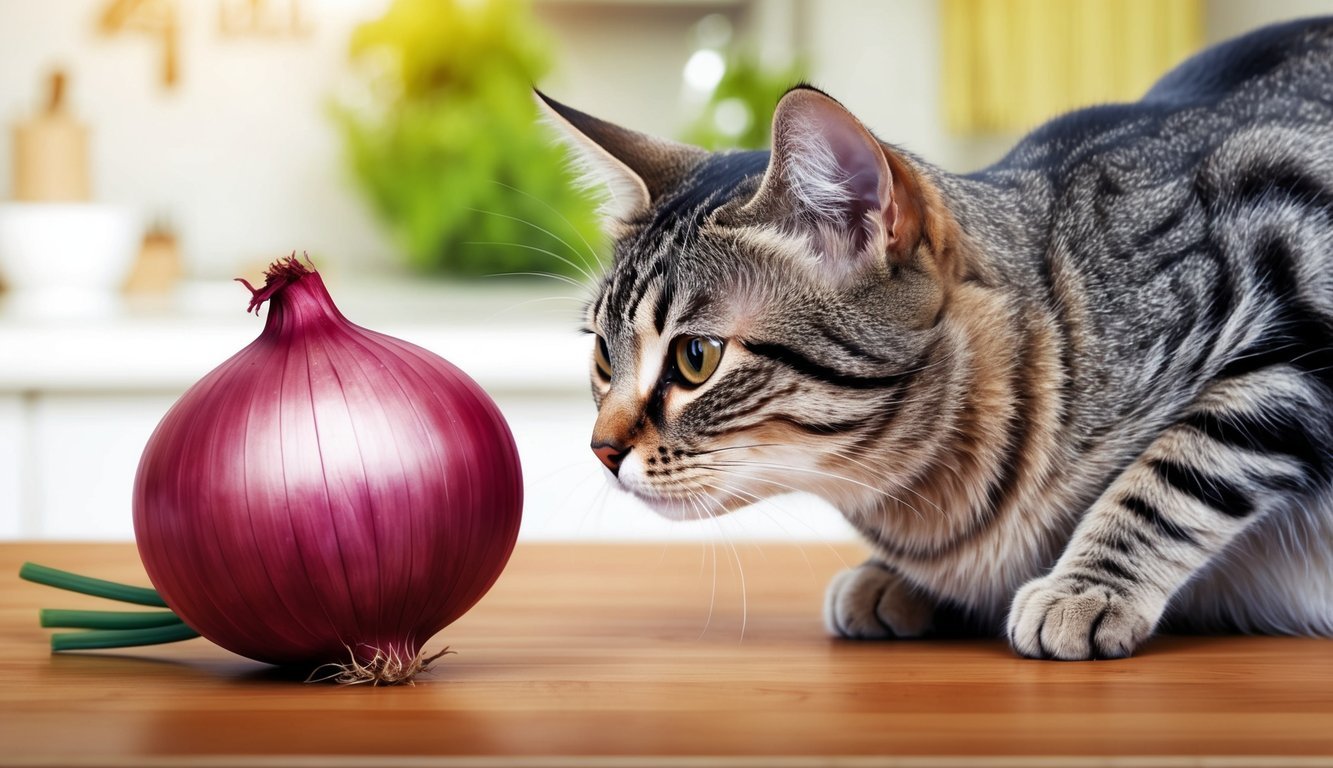
To prevent onion toxicity in cats, it’s essential to educate yourself and others about the dangers of onions and their relatives.
Awareness can significantly decrease the number of cases seen each year.
Educating Pet Owners
Knowledge is power when it comes to pet safety.
You should inform friends and family about the risks associated with feeding onions to cats.
- Know the Symptoms: Familiarize yourself with signs of onion toxicity, such as vomiting, diarrhea, or lethargy.
- Read Labels: Always check food labels for onion or garlic content. Some pet foods or treats may contain hidden sources.
- Share Information: Use social media or community events to raise awareness about onion toxicity in pets.
The more people know, the less likely they are to inadvertently harm their cats.
Alternatives to Onions for Cat Safety
If you’re looking to add flavor to your cat’s meals, there are safer alternatives.
Here are some cat-friendly options that you can use instead of onions:
- Herbs: Use catnip or parsley in small amounts. These can be safe and enjoyable for your cat.
- Fish Oil: A few drops can enhance flavor and provide nutritional benefits.
- Vegetables: Consider steamed carrots or peas. These are generally safe and can be offered in moderation.
Avoid any food with onion or garlic, as these can lead to serious health issues.
Staying vigilant about what you feed your cat will help prevent onion toxicity and keep your pet safe.
Recognizing and Reacting to Emergencies
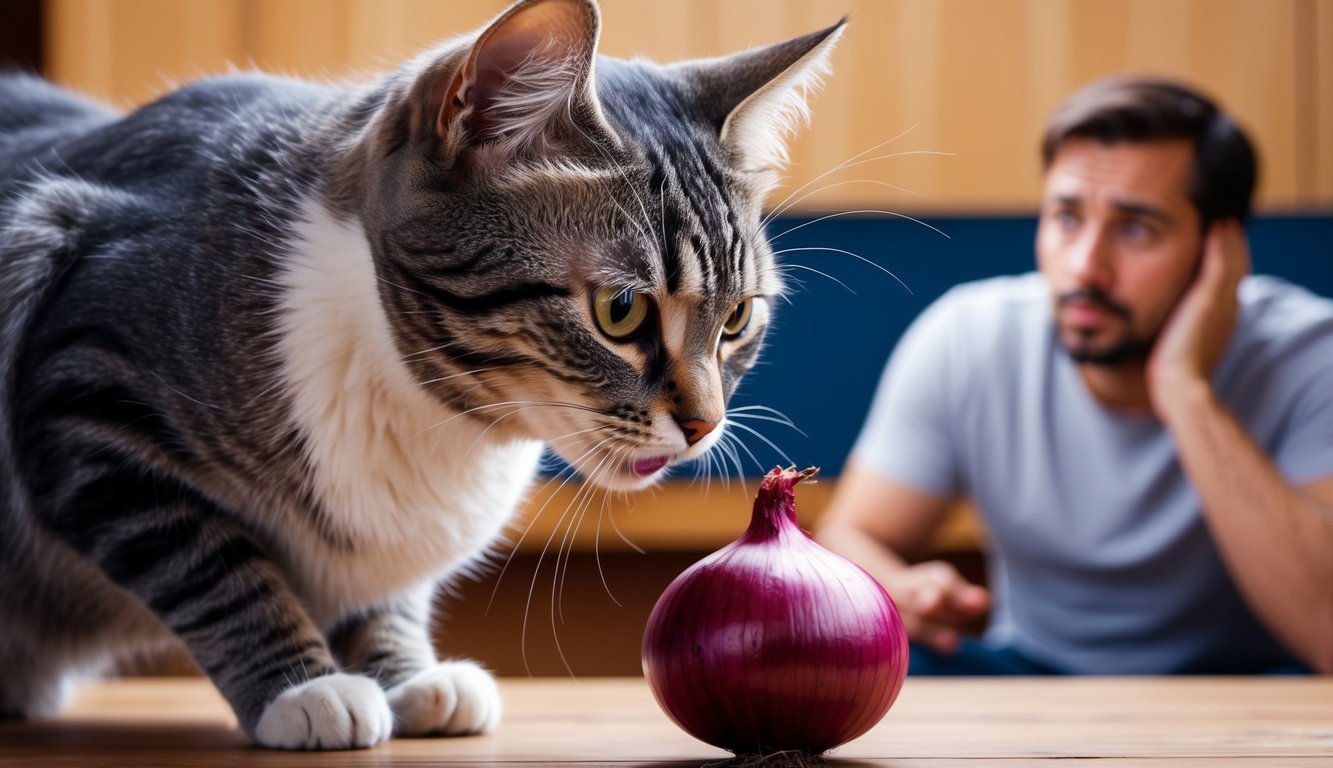
It’s crucial to be aware of the signs that indicate onion toxicity in your cat, as well as the necessary actions to take in an emergency.
Quick recognition and response can make a significant difference in your pet’s recovery.
Identifying the Signs of Onion Poisoning
Be vigilant for symptoms that suggest onion poisoning, which can occur with even small amounts of onion.
Common signs include:
- Lethargy: Your cat may seem unusually tired or inactive.
- Vomiting: This can occur soon after ingestion.
- Diarrhea: Watch for changes in stool consistency.
- Increased Heart Rate: Monitor your cat for signs of rapid heartbeat.
Other indicators like pale gums and weakness can also signal the seriousness of the situation.
If you suspect your cat has ingested onions, take note of the quantity and timeframe, as these details are essential for veterinary evaluation.
Critical Veterinary Interventions
If you recognize signs of onion toxicity, acting quickly is vital.
Contact your veterinarian immediately.
They may recommend several interventions, including:
- Inducing Vomiting: If ingestion was recent, this may help eliminate the toxin.
- IV Fluids: Administering fluids can help flush toxins from the system and prevent dehydration.
- Monitoring Blood Work: Your vet might perform tests to check for damage to red blood cells.
Timely veterinary care is essential in managing onion poisoning effectively.
Don’t hesitate to reach out for professional help.
Early intervention can greatly improve your cat’s chances of recovery.
Frequently Asked Questions
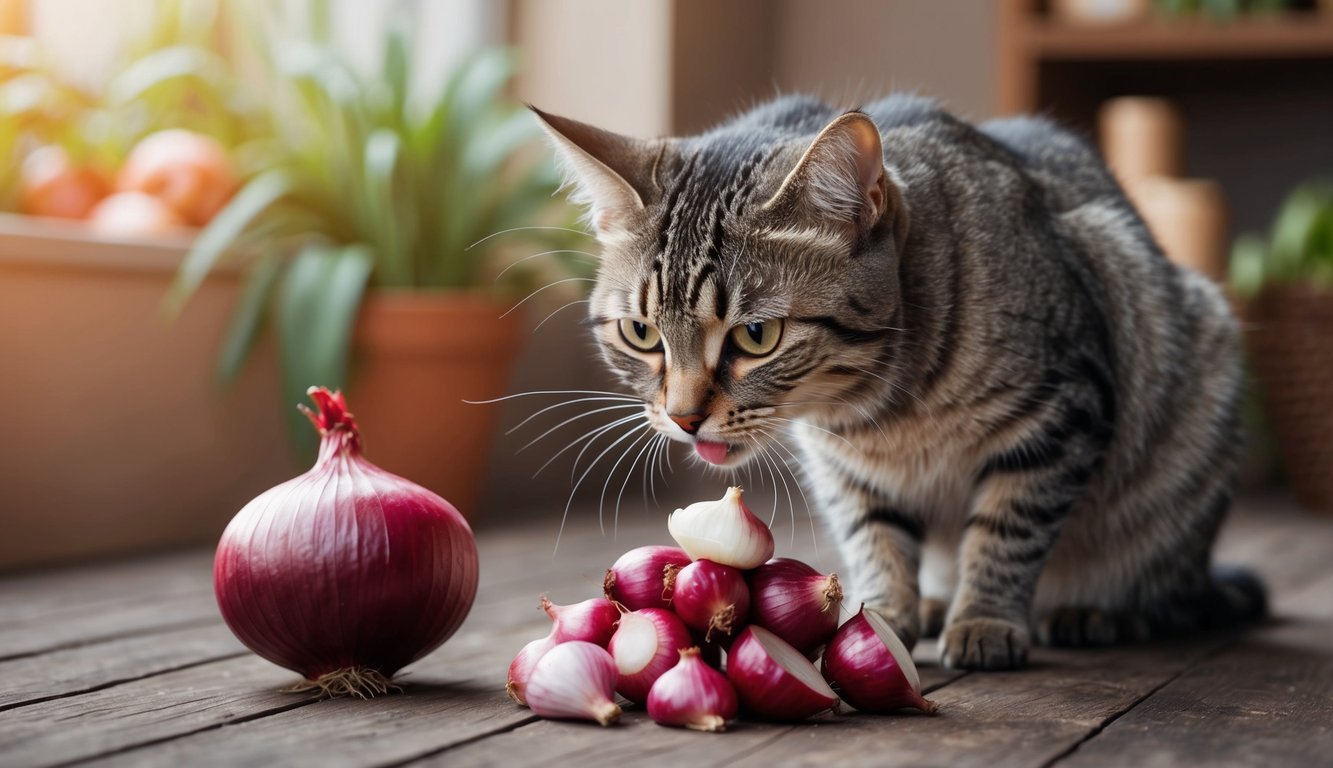
Onion poisoning can pose serious risks to your cat’s health.
Understanding the symptoms, timing, and management of such toxicity is crucial for pet owners.
What are the symptoms of onion poisoning in cats?
Common symptoms include vomiting, diarrhea, lethargy, and weakness.
You might also notice your cat having difficulty breathing or a rapid heart rate.
How long does it take for onion toxicity symptoms to appear in a cat?
Symptoms may appear within a few hours to a couple of days after ingestion.
The timing can vary based on how much onion was consumed and the individual cat’s sensitivity.
Can a small amount of onion be harmful to cats?
Yes, even small amounts can be toxic.
Studies suggest that as little as 5 grams of onion per kilogram of body weight can pose a risk.
What should I do if my cat ate a piece of onion?
Contact your veterinarian immediately.
They can provide guidance, and you may need to take your cat in for an examination or treatment.
Is there a difference in toxicity between raw and cooked onions for cats?
Both raw and cooked onions are toxic.
Cooked onions may still contain harmful compounds that can affect your cat’s health.
How does onion poisoning affect a cat’s health?
Onion poisoning primarily affects red blood cells.
This leads to a condition known as Heinz body anemia.
This impacts the blood’s ability to transport oxygen, which can be life-threatening if not treated.


